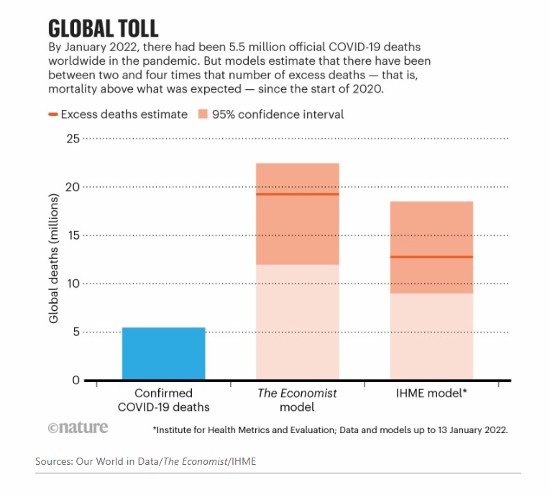In a news feature appearing in Nature this week, David Adam talks about the official global death toll from COVID-19 and how it significantly underrepresents the real numbers. Tallying deaths in an evolving health crisis is never easy because we focus our efforts on saving lives, not counting the ones we have lost. But the truth is that we need an accounting that is real and not one that allows for future misinterpretations of COVID-19’s impact.
The official number who had died from COVID-19 as of January of this year is 5.5 million. Data models however estimate a number between two and four times higher based on looking at excess death rates happening around the planet. Excess death estimates over and above the norm is not an exact science. A demographer (people who study human populations and their characteristics), Tom Wilson, at the University of Melbourne in Australia, notes that many countries use average-five-year deaths data as the expected rate. Anything over that number is defined as excess. More sophisticated models take into consideration the structure of the population noting that an ageing population sees a rise in annual deaths over time which then alters numbers defined as excess.
Ariel Karlinsky, an economist at the Hebrew University of Jerusalem, and Dmitry Kobak, a data scientist at the University of Tübingen, have created the most comprehensive excess-mortality data for the years running from 2015 to the end of 2021. it includes deaths from disease, conflict, natural disasters, and climate change.
So how do their estimates vary from officially reported government mortality statistics? A good example is Russia. By the end of last year, the Russian government reported over 300,000 deaths from COVID-19. Karlinsky and Kobak’s data considers this a dramatic underestimate putting the number at over 1 million. Other countries where the official deaths reported represent a deviation from reality include Mexico, Iran, South Africa, Egypt, India, China and The Philippines to name a few. In fact, the modelling data they report shows that excess deaths related to COVID-19 are 1.6 times greater than what we see in official statistics. That’s 1.6 times 5.5 million, or 8.8 million.
Karlinsky and Kobak estimate Chinese COVID-19 deaths at 750,000, 150 times greater than the government’s 4,600 official statistics. And India’s official numbers at just under 500,000 is actually closer to 5 million.
The Economist, the news magazine from the United Kingdom, uses machine-learning in coming up with its excess deaths count attributable to COVID-19, noting that the truer number of fatalities from the virus may be closer to 12 million at the lower end of the scale and 22 million at the top.
The Institute for Health Metrics and Evaluation (IHME), a University of Washington-based independent health research centre uses a different model than Karlinsky and Kobak. The IHME estimates are more fluid in range showing that deaths from COVID-19 so far amount to between 9 and 18 million, a far cry from the 5.5 million official number.
In another study done by epidemiologists out of the University of Toronto, a telephone survey of adults in India designed to track pandemic deaths concluded that by July of 2021, the country had already seen 3 million succumb to COVID-19, a number 6 to 7 times higher than official statistics.
In a novel use of satellite data, The London School of Hygiene and Tropical Medicine has been able to estimate deaths by looking at images of a country and counting the number of new graves. Looking at pictures from Yemen cemeteries showed weekly burial rates up 230% during the COVID-19 pandemic between April and September of 2020. A similar analysis of new graves from Somalia satellite images showed excess deaths from January to September of 2020 amounting to an increase of 368%.
The challenge remains to accurately assess the damage COVID-19 has done to countries around the world, Data scarcity, cultural differences in how death is reported, regulations around burial and cremation, and more make it a challenge. Andrew Noymer, a demographer at the University of California, Irvine has remarked that counting deaths is a problem for statisticians that goes back more than a half-century. The best it seems we can do is “estimate demographic rates in the absence of hard data.” Noymer goes on, “We still don’t know how many people died in the 1918 pandemic, but I always figured we would know pretty well how many people would die in the next one because we live in the modern world…But we don’t actually, and that’s kind of sad for me as a demographer.”
The one thing we do know is that the 5.5 million number for those who have succumbed to COVID-19 is way off the mark. Not that 5.5 million trivializes the real extent of the tragedy for humanity. That’s already far too big a number. But when the real number is finally enumerated, the true impact of these last two pandemic years will tragically be known.










